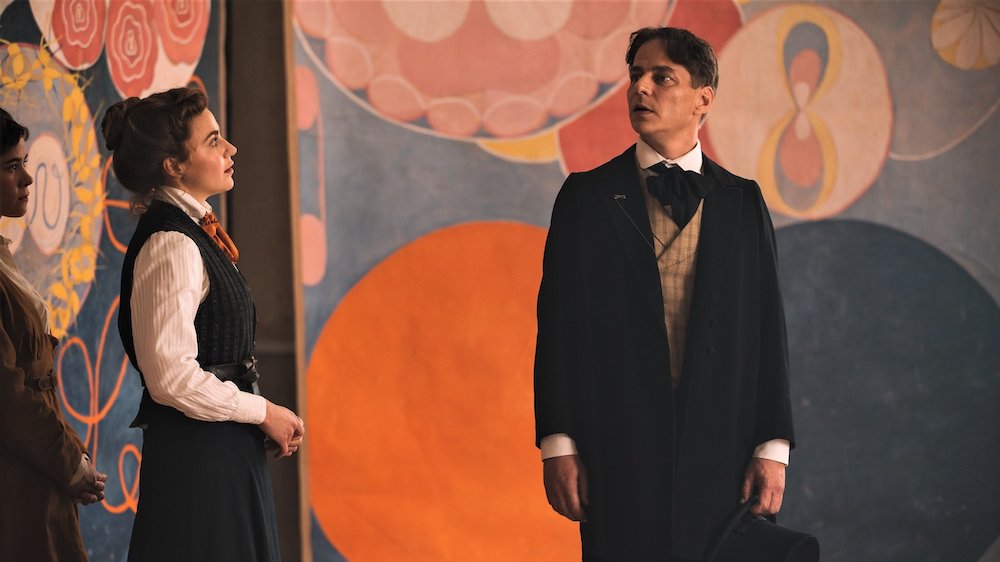Artists and the art world are a source of endless fascination for the movies. They seem inherently romantic or scandalous—or both—and in the past these movies usually featured white guys such as Michelangelo, van Gogh or Jackson Pollock in postures of tragic genius. Fortunately, we’ve moved away from the Great White Male Artist trope, especially as some neglected women artists have been rediscovered.
One would be Hilma af Klint (1862–1944), a visionary Swedish artist now credited as being one of the first abstract painters, predating Kandinsky and Mondrian. Her life has been imagined into the biopic Hilma, directed by veteran director Lasse Hallström, with his daughter Tora Hallström playing the young Hilma, and his wife Lena Olin playing the older Hilma. If that sounds like trouble, you’d be half-right.
Af Kling trained at the Royal Academy in Stockholm and painted her share of portraits and landscapes to make a living, all the while enduring male contempt, as the movie reveals. But she had a higher calling, a mystical one. “I want to study the world,” her character says in the film, “and see how things are connected.” Eventually she heeded her inner voice and joined four other women to form a group called “The Five,” to worship and seance together. In her 40s, she began making very large geometric paintings, believing them to be channeled and meant for the “Temple.” Toward the end of her life, she believed these works to be ahead of their time—which indeed they were—and had them put away in storage. That’s how the story goes, and Hallström follows the convention. What’s sad but definitely true is that in Klint’s time these works were rarely shown in public.
This artist seems a perfect subject for a biopic, with her revolutionary art and her proto-feminist leanings. Unfortunately, this film portrays her as a petulant teenager, with a circle of giggling and girlish female friends. It’s so sad to see her story trivialized, and her lovers treated more as utilitarian than heartfelt—one of them is quite wealthy, so her purse helps pay for af Klint’s expenses and many dinners out. The next one appears to be her housekeeper. With the director’s daughter cast as the title character, all the other characters got severely underwritten. On the other hand, the brief appearances of the soulful Lena Olin made me wish she had far more screen time.

Still from the biopic “Hilma” (2022), ©Juno Films.
For those of us who were charmed by the unexpected twists and turns of Kelly Reichardt’s First Cow (2019), her new film, Showing Up, is quite a disappointment. Protagonist Lizzy is a ceramic artist, played by Michelle Williams with dreary listlessness. She has a boring admin job at an arts-and-crafts college in Portland, Oregon, and is preparing for her own solo show at a local gallery. Meanwhile, she has no hot water, and her landlady is too busy to deal with it because she’s also an artist—having two shows opening soon. Lizzy’s family, naturally, is also dysfunctional.
Lizzy’s parents are divorced, and her mother runs the department in which Lizzy works; her father is a narcissist, and her brother is on the spectrum. It’s not clear why Lizzy takes it upon herself to try to fix everything, especially when she’s so unhappy about doing it and seems to be running out of time to prep for her show.
This is a slow film, and one particularly long scene of Lizzy shaping a clay figure with her fingers feels like a documentary insert. Perhaps one on-target message the film gets across is that the life of an artist isn’t all fun and openings; a lot of it may be a grind. However, most artists I know get a lot more pleasure out of their work than Lizzy does.
The Melt Goes on Forever: The Art & Times of David Hammons captures an artist’s life in an informed and captivating way. Directors Judd Tully and Harold Crooks skillfully intercut archival footage with interviews with friends and colleagues (Betye Saar, Suzanne Jackson, Henry Taylor, Lorna Simpson), and even a few with the publicity-shy artist himself.
We see the remarkable range of Hammons’ work, and the originality of his thinking. Many of us know Hammons for his body prints, in which he applied his own oiled body to large sheets of paper, then added charcoal or other pigment. Initiated in 1968 and continuing for about a decade, these were very much about Black identity and its social suppression. But this film shows us he did so much more in the way of sculpture and performance art, once setting up a blanket on the streets of New York in 1983 to sell snowballs, and calling it Bliz-aard Ball Sale. Some sections of the doc are also illustrated with animation, a style that looks like torn paper—and it works.



















0 Comments